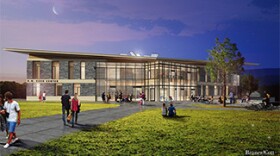A ribbon-cutting ceremony today marked the opening of the first new building on the Hampshire College campus in nearly three decades. But it is no ordinary building. It was designed and built to achieve the most advanced environmentally sound building standard in the world.
The new 17,000-square-foot campus center, the R.W. Kern Center, was constructed using non-toxic materials that were locally sourced whenever possible to reduce the carbon footprint. The building is designed to supply its own power and water and process waste on-site.
College president Jonathan Lash said it is a symbol of the school’s beliefs.
" We want this building to not just be a structure that houses some activities, but a part of who we are and how we teach," Lash said in an interview.
The new building will house admissions and financial aid. There will be classrooms and a coffee bar.
Hampshire College worked with architects Bruner-Cott of Cambridge, Mass. to design the building with the goal of being certified a “living building” by the International Living Future Institute. There are currently nine such buildings in the world with more awaiting certification or under construction.
The two-story timber beam-and-post building has solar panels on the roof to supply power. There are two 5,500-gallon cisterns that hold rainwater, which is purified for drinking. All the organic waste ends up in large composters.
Kern Center builder Jonathan Wright of Wright Builders in Northampton said the project was “difficult and exacting.”
Wright, a Hampshire College alum, said the most difficult challenge in the project was avoiding the use of any construction materials or chemicals found on a so-called “red list” of about a dozen toxins.
" A building like this, if it was conventional, might have 150 submittals;products you have to bring forward and say this is want we plan. This building has over 800 submittals; everything from the electrical tape to chalks and glues, " explained Wright. " It is very process intensive."
With the exception of the heat pumps for the building, which came from Japan, and frames for the window glass that came from Germany, everything else, including the stone veneer and the eastern white cedar shingles were fabricated within 500 kilometers of the construction site, according to Wright.
" That is part of the Living Building Challenge is to source it locally," said Wright.
All wood that was used was certified by the Forest Stewardship Council or came from salvage. Wright and the college’s Facilities and Grounds office worked to reduce or eliminate construction waste through recycling.
Students were involved in the project from the start. Wesley Evans, a senior majoring in applied design, joined the planning committee for the Kern Center when he was freshman.
" We did not know at the time the level of sustainability the Kern Center would have or the depth and rigger that would go into the planing process," said Evans. " What came out of it really is a testament to how involved the community was , how deeply the Hampshire community cares about sustainability and leaving the planet better than we found it."
Carl Weber, associate director of Facilities and Grounds, said it will be at least a year before the college finds out if the Kern Center achieves the Living Building Challenge standard.
" After a certain amount of time we have to be able to prove we did what we said we would." said Weber
The Hitchcock Center for the Environment, a nonprofit education center, is constructing a new building on the Hampshire campus that is also designed to meet the Living Building Challenge standard.












